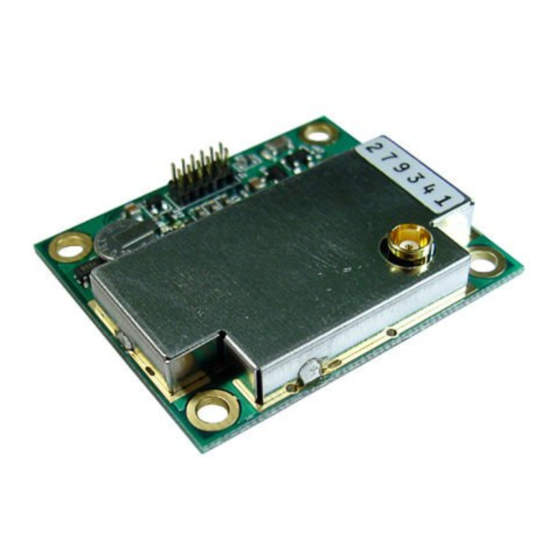Advertisement
Quick Links
Àô¤Ñ½Ã¬P¬ì§ÞªÑ¥÷¦³--¤½¥q
PRODUCT USER MANUAL
GPS ENGINE BOARD
ET-332
GlobalSat Technology Corporation
¥x¥_¿¤¤¤©M¥««Ø¤@¸ô 186 ¸¹ 16 ¼Ó(»·ªF¥@¬ö¼s³õ )
16, No.186,Chien 1 Road, 235Chung Ho City,Taipei Hsien, Taiwan ,R.O.C.
Tel: 886-2-8226-3799(Rep.)
Fax: 886-2-8226-3899
Web:
www.globalsat.com.tw
E-mail:
service@globalsat.com.tw
Advertisement

Summary of Contents for Globalsat ET-332
- Page 1 Àô¤Ñ½Ã¬P¬ì§ÞªÑ¥÷¦³--¤½¥q PRODUCT USER MANUAL GPS ENGINE BOARD ET-332 GlobalSat Technology Corporation ¥x¥_¿¤¤¤©M¥««Ø¤@¸ô 186 ¸¹ 16 ¼Ó(»·ªF¥@¬ö¼s³õ ) 16, No.186,Chien 1 Road, 235Chung Ho City,Taipei Hsien, Taiwan ,R.O.C. Tel: 886-2-8226-3799(Rep.) Fax: 886-2-8226-3899 Web: www.globalsat.com.tw E-mail: service@globalsat.com.tw...
- Page 2 Features: SiRF star¢» high performance GPS Chip Set Very high sensitivity (Tracking Sensitivity: -159 dBm) Extremely fast TTFF (Time To First Fix) at low signal level Compact size (40.5mm * 35 mm * 10mm) suitable for space-sensitive application Support NMEA 0183 and SiRF binary protocol Build-in SuperCap to reserve system data for rapid satellite acquisition.
- Page 3 Acceleration Less than 4g Jerk 20m/sec **3 Power Main power input 3.8V ~ 6.5V DC input Power consumption 75mA (Continuous mode) 30mA (Trickle power mode) Interface Baud rate 4,800 to 57,600 bps adjustable Output message SiRF binary or NMEA 0183 GGA, GSA, GSV, RMC, VTG, GLL Environmental Operating Temp -40¢J to +85¢J...
-
Page 4: Physical Characteristics
Physical Characteristics... -
Page 5: Interface Description
Interface Connection * Pin-out of the 12-pin interface connector Number Name Description Type Ground VBAT Backup Battery Input 3.8V~5.5V DC Power Input Input PBRES Push Button Reset Input (Active Low) Input GPIO1 (Reserved) Serial Data Output A (GPS Data) Output Serial Data Input A (Command) Input Ground... - Page 6 faster start-up offered by a hot or warm start, a battery backup must be connected. To maximize battery lifetime, the battery voltage should be between 2.5v and 3.6v. * PBRES (Push button reset): This pin provides an active-low reset input to the engine board. It causes the engine board to reset and start searching for satellites.
- Page 7 SOFTWARE COMMAND NMEA Output Command GGA-Global Positioning System Fixed Data Table B-2 contains the values for the following example: $GPGGA,161229.487,3723.2475,N,12158.3416,W,1,07,1.0,9.0,M,,,,0000*18 Table B-2 GGA Data Format Name Example Units Description Message ID $GPGGA GGA protocol header UTC Time 161229.487 hhmmss.sss Latitude 3723.2475 ddmm.mmmm N/S Indicator...
- Page 8 GLL-Geographic Position-Latitude/Longitude Table B-4 contains the values for the following example: $GPGLL,3723.2475,N,12158.3416,W,161229.487,A*2C Table B-4 GLL Data Format Name Example Units Description Message ID $GPGLL GLL protocol header Latitude 3723.2475 ddmm.mmmm N/S Indicator N=north or S=south Longitude 12158.3416 dddmm.mmmm E/W Indicator E=east or W=west UTC Position 161229.487...
- Page 9 GSV-GNSS Satellites in View Table B-8 contains the values for the following example: $GPGSV,2,1,07,07,79,048,42,02,51,062,43,26,36,256,42,27,27,138,42*71 $GPGSV,2,2,07,09,23,313,42,04,19,159,41,15,12,041,42*41 Table B-8 GSV Data Format Name Example Description Message ID $GPGSV GSV protocol header Number of Messages Range 1 to 3 Message Number Range 1 to 3 Satellites in View Satellite ID Channel 1(Range 1 to 32)
- Page 10 VTG-Course Over Ground and Ground Speed $GPVTG,309.62,T,,M,0.13,N,0.2,K*6E Name Example Units Description Message ID $GPVTG VTG protocol header Course 309.62 degrees Measured heading Reference True Course degrees Measured heading Reference Magnetic Speed 0.13 knots Measured horizontal speed Units Knots Speed Km/hr Measured horizontal speed Units Kilometers per hour...
-
Page 11: Set Serial Port
NMEA Input Command . Set Serial Port ID:100 Set PORTA parameters and protocol This command message is used to set the protocol(SiRF Binary, NMEA, or USER1) and/or the communication parameters(baud, data bits, stop bits, parity). Generally,this command would be used to switch the module back to SiRF Binary protocol mode where a more extensive command message set is available. - Page 12 B). Navigation lnitialization ID¡G 101 Parameters required for start This command is used to initialize the module for a warm start, by providing current position ¡] in X, Y, Z coordinates¡^,clock offset, and time. This enables the receiver to search for the correct satellite signals at the correct signal parameters. Correct initialization parameters will enable the receiver to acquire signals more quickly, and thus, produce a faster navigational solution.
- Page 13 could decrease needed throughput by reducing the number of active channels UBYTE <ResetCfg> bit mask 0×01=Data Valid warm/hotstarts=1 0×02=clear ephemeris warm start=1 0×04=clear memory. Cold start=1 UBYTE Example: Start using known position and time. ¢CPSRF101,-2686700,-4304200,3851624,96000,497260,921,12,3*7F C). Set DGPS Port ID:102 Set PORT B parameters for DGPS input This command is used to control Serial Port B that is an input only serial port used to receive RTCM differential corrections.
- Page 14 D). Query/Rate Control ID:103 Query standard NMEA message and/or set output rate This command is used to control the output of standard NMEA message GGA, GLL, GSA, GSV RMC, VTG. Using this command message, standard NMEA message may be polled once, or setup for periodic output. Checksums may also be enabled or disabled depending on the needs of the receiving program.
- Page 15 E). LLA Navigation lnitialization ID:104 Parameters required to start using Lat/Lon/Alt This command is used to initialize the module for a warm start, by providing current position (in Latitude, Longitude, Altitude coordinates), clock offset, and time. This enables the receiver to search for the correct satellite signals at the correct signal parameters.
- Page 16 <ResetCfg> bit mask 0×01=Data Valid warm/hot starts=1 0×02=clear ephemeris warm start=1 0×04=clear memory. Cold start=1 UBYTE Example: Start using known position and time. ¢CPSRF104,37.3875111,-121.97232,0,96000,237759,922,12,3*37 F). Development Data On/Off ID:105 Switch Development Data Messages On/Off Use this command to enable development debug information if you are having trouble getting commands accepted.







Need help?
Do you have a question about the ET-332 and is the answer not in the manual?
Questions and answers